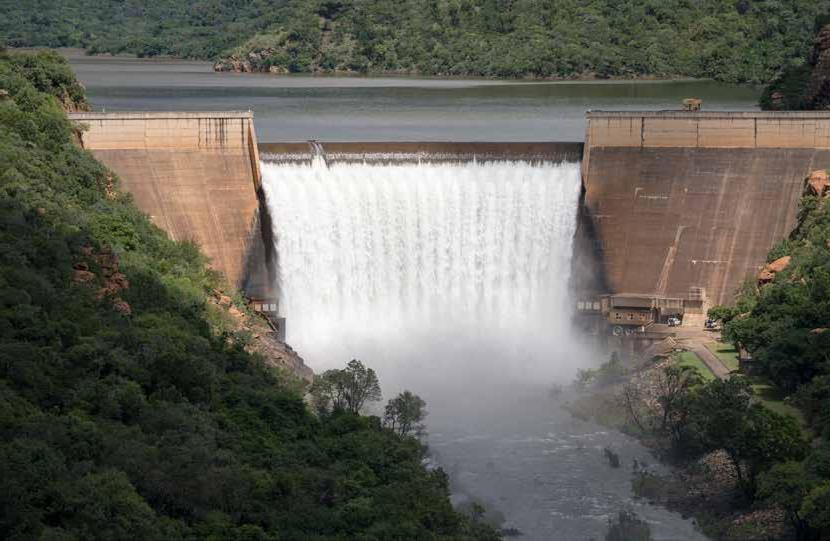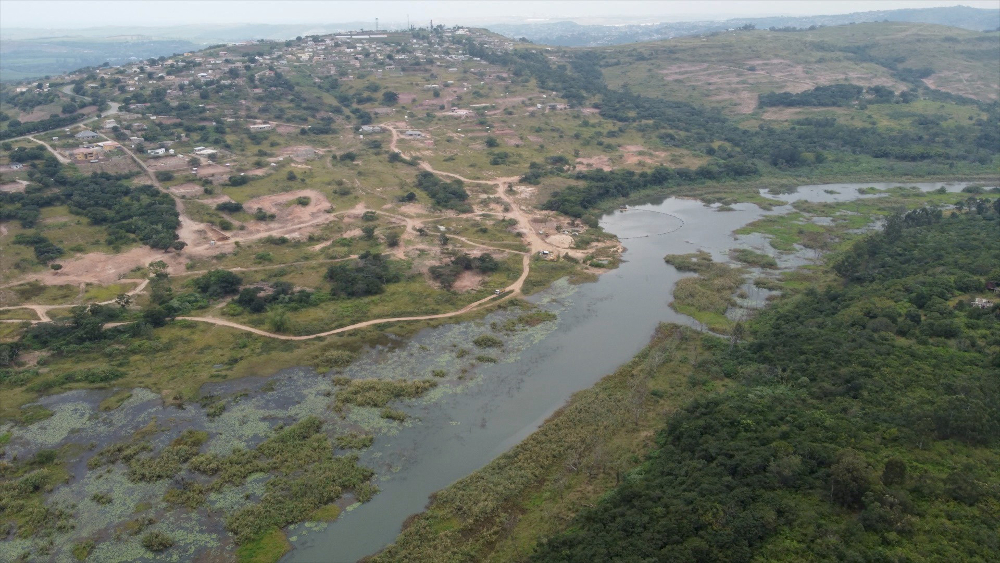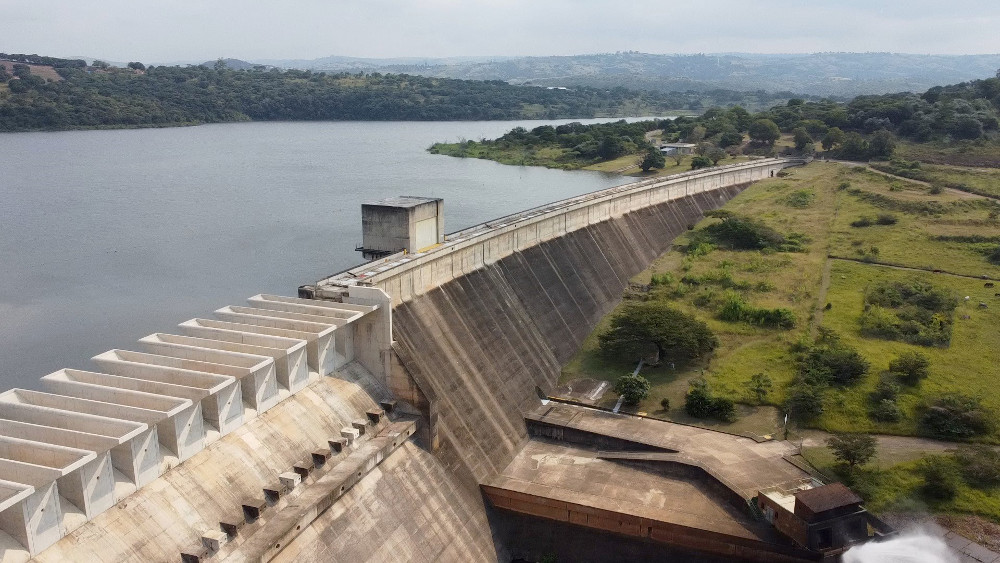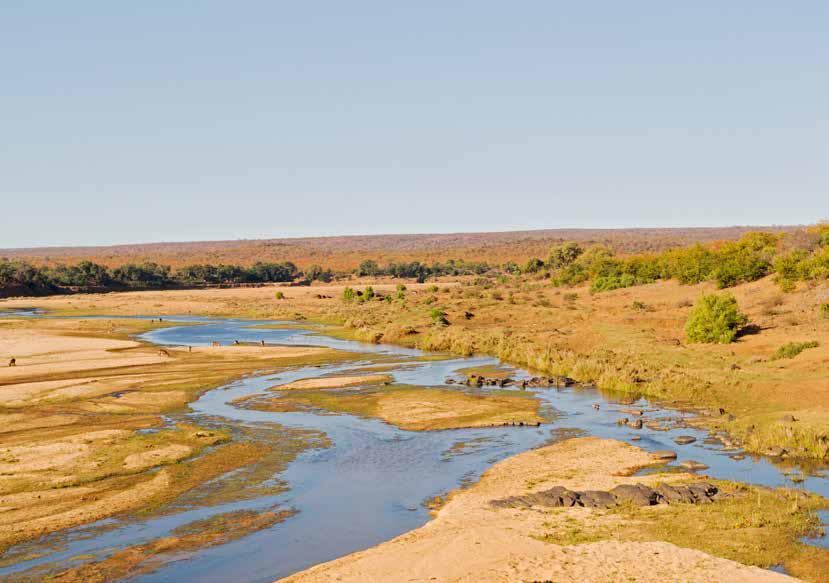National siltation programme will ensure longevity of South Africa’s large dams
As a water-scarce country with an extremely variable rainfall, both in space and in time, South Africa is highly dependent on the storage of water in large dams for its water supply. Nationally, the total storage capacity of the major reservoirs in the country amounts to an estimated 33 900 million cubic metres, or about 70% of the mean annual runoff from the land surface of the country. Most of South Africa’s dam infrastructure was constructed before 1980, and thus many of these engineering structures are decades old. In addition, seven of South Africa’s nine provinces rely on inter-basin transfers — where water is transferred from one catchment to another through sophisticated water infrastructure — which provide more than half of their water requirements.
However, these large dams experience various threats to their sustainability, not least of which is siltation. South African rivers, in general, carry large loads of suspended silt, both as a result of natural processes and as a result of human-induced activities such as deforestation, industry activities, improper farming techniques and overgrazing. Silt ends up in the country’s dams, where it reduces the storage capacity. The problem is exacerbated by an increase in high-intensity rainfall events coupled with longer periods of aridity as a result of climate change.

All of South Africa’s dams are affected by siltation to a greater or lesser degree. The most well-known example is the Welbedacht Dam on the Caledon River in the Free State Province. The dam was originally constructed in 1973 with the purpose of supplying water to the city of Bloemfontein. By 1988, just 15 years after construction, the dam had already lost 73% of its original storage capacity. Another example is Hazelmere Dam, located on the Mdloti River in KwaZulu-Natal. This dam, completed in 1975, has lost more than 25% of its original design capacity through siltation.
It is estimated that South Africa is losing about 1% of storage capacity in its dams to siltation every year. The limits to the development of surface water sources have almost been reached and the opportunities for the spatial economic placement of new dams are few. Dam construction is costly, and it is not cost-effective to replace the lost capacity in existing water infrastructure by building more bulk water infrastructure. It is therefore imperative that the country manages its existing bulk water infrastructure as effectively as possible, and extends the storage life of its existing large dams. There are several options for preventing and managing siltation in South Africa’s dams. Siltation management should not be a blanket approach, and should be site specific.
There is thus a requirement for a toolbox of solutions to address the siltation challenge in South Africa. To this end, the Department of Water and Sanitation (DWS) appointed the Water Research Commission (WRC) to develop the National Siltation Management Strategy for Large Dams in South Africa, more commonly known as the NatSilt Programme. The programme represents a collaborative, transdisciplinary approach to tackle the wide spectrum of dam siltation and storage capacity challenges in South Africa.

Leonardo Manus, Acting Deputy Director-General of Regulations, Compliance, and Enforcement at the DWS, said: “We have established our whole economy and livelihoods around these majestic dam structures, but we can so easily lose them if we don’t apply proper management procedures to keep them in that state.
“The NatSilt Programme will provide the department with tools and intelligence to make appropriate, site-specific decisions regarding each dam instead of having a blanket approach,” he added. “Where sedimentation occurs to such an extent that it has to be dealt with, we will create a business model that will not be to the detriment of those who are dependent on the dam. To minimise costs to the downstream users in that specific catchment, we need to find alternatives to expensive methodologies and dredging models deployed to keep any dam operating.”
The NatSilt Programme thus aims to ensure that bulk water resource infrastructure is managed in an efficient, effective and sustainable manner to ensure economic growth, social development and poverty eradication. The programme will provide a package of siltation management solutions as well as an overall strategy. “With this programme we hope to address some of the water challenges the country is facing, but also to establish a collaborative approach to dealing with matters affecting the water sector, rather than organisations and institutions working in silos,” explained WRC Senior Project Manager Lesego Gaegane.
“Siltation of dams is a worldwide problem, which results in the loss of storage capacity and so exacerbates water insecurity. Effective siltation prevention and management will save scarce fiscal resources by extending the life cycle of our existing dams.”
The programme is being undertaken in three phases, the first of which is already underway. The main objective of phase one is the development of the Siltation Management Strategy to prevent and manage the siltation of dams as well as stimulate local economies and recover costs. The strategy will be supported by:
- Risk management and monitoring and evaluation frameworks
- Governance and financial considerations
- Implementation plan
- Future research requirements.
The development of the National Siltation Management Strategy will be designed to enable the project teams to cross-pollinate and share information with each other, as their work is interlinked.
The strategy development process will provide a situational analysis, engage a broad range of stakeholders, map the drivers and challenges linked to potential solutions , and provide an up-to-date state of dam siltation management in South Africa. Further primary data collection will be required to complement that of the DWS databases and modelled to identify siltation prone areas, siltation rates, and load and quality characteristics, among others. This will result in a framework for dam storage design and management. International partners will be included and global practises will be benchmarked to review current management practices

Phase one will also see the investigation of current models utilised to manage siltation in South Africa. The objective is to generate and test tools that will enable the alleviation of dam siltation through optimised catchment management as well as dam engineering methodologies and innovations. An Operations Model will be proposed to optimise and enhance dam management plans, processes, procedures, regulation and compliance. A toolbox will be developed alongside this that will delve into critical decision areas, system indicators and management boundaries in relation to efficient and effective siltation management.
As part of a risk monitoring framework, real-time monitoring indicators and responses will be proposed, including costs to operationalise. For new dams, design considerations will be developed to ensure siltation is minimised as well as considerations of the cost-benefit of dam basin management versus siltation of the dam.
As things stand there has been a development of the framework and operations model which will be implemented as the projected continues. This will not be applied in isolation as the implementation of the developed framework and model will take into consideration the operations and safety manuals of the specific dams. the This will be evident in the pilot phase of the programme. Socio- Ecological aspect affecting dams and catchment areas will also be addressed in implementing the Programme.
Dredging can be a technique to deal with sediment in dams, although it is seen by many as an expensive solution that is highly site specific. There are a number of advantages and disadvantages when it comes to dredging. These factors, together with frequency, cost/benefit and environmental risk will be investigated towards the development of a dredging model that will guide such activities in South Africa. Priority sites will be identified through a consultative process to capture areas requiring intervention. The considerations for the sources for the information that will be used to ensure the sustainability of the dams through the developed model will be vital for the effective implementation of this programme. To effectively implement these interventions, the types of required personnel will need to be identified and the quantity. This has been one of the considerations that have been focused on through the development of the Dredging models.

It has been recognised that all the dam siltation management tools and strategies will not be implementable without a parallel capacity building component to support new skills development and skills transfer through the project and its design. The programme is developing training material, modules and four skills programme’s in the first phase to support a successful and value-adding phase two. The skills programmes that are being developed are occupation based. The aim of the Skills programmes are to offer a building block to full qualifications. The four Skills programmes will be registered as National Skills Programmes with the Quality Council for Trades and Occupation (QCTO).
Phase two
Phase two is expected to start during the second year of the NatSilt Programme later during this year, which will run in parallel with the close out of phase one. Phase two will entail the piloting of the decision-making tools, operations models, dredging models and protocols, capacity building and monitoring and evaluation indicators.
Three sites have been identified where these tools and models will be piloted. They are:
- Welbedacht Dam (Free State)
- Hazelmere Dam (KwaZulu-Natal)
- Darlington Dam/Orange-Fish Government Water Scheme (Eastern Cape).
Phase three
Phase three is the culmination of the programme. This phase will involve taking the learnings from Phase 1 and 2 and revising the strategy, adapting and improving the models and tools based on stakeholder engagement and pilots.
The NatSilt Programme will be concluded at the end of 2023.

Dam siltation under the spotlight with new national programme
The need for immediate water security interventions linked to economic competitiveness was discussed during the recent National Dam Siltation Symposium (NatSilt Symposium) on Protecting Our Source Water Systems, a virtual event held over two days in May 2021.
Importantly, the symposium also saw the launch of the National Dam Siltation Management Programme.
Other key outcomes of the symposium included the role municipalities play in the maintenance of the catchment areas and how crucial it is that there is co-operation between the various government departments in ensuring success of the programme.
Due to increasing silt loads in a number of local dams, the pilot projects under the WRC and DWS Siltation Management Strategy for Large State Dams will help to guide wider national initiatives.

The National Dam Siltation Management Programme is essential in aiding the decision- making for which strategies to employ for current and future dams, and is “absolutely critical to the country’s water security” as emphasised by the WRC chief executive officer, Dhesigen Naidoo during the NatSilt Symposium. Department of Water & Sanitation ministerial advisor Jurgen Kogl pointed out at the recent NatSilt virtual symposium that dealing with siltation was sometimes viewed as a grudge purchase, in a similar way to how consumers often viewed buying life insurance.
However, because of the massive cost of building new dams, the problem of siltation has to be tackled swiftly and “head on”, in order to extend the lifespan and capacity of existing infrastructure to be able to supply water for South Africa’s fast developing and growing population.
For more information, visit: https://wrcnatsilt.org.za


